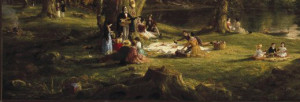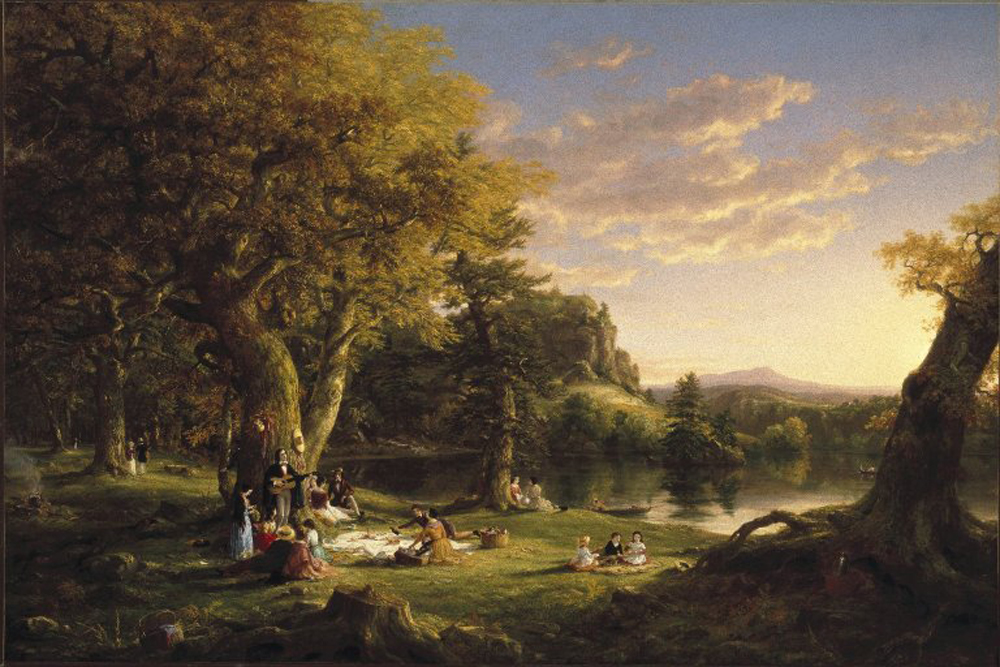Cole’s Pic-Nic Party is a standout for its joie de vivre. It’s not just another of Cole’s numerous “sylvan” scenes,” which his hyperbolic biographer Louis Noble described as being “all American, wide, bright polished water, manifold woods over all the sweet glad light and quiet air and everywhere the sense of beauty with the wilderness.”
When Cole received an open-ended commission, he chose the picnic because it was something his family liked to do. * He might have been prompted by a wish for a happier future when he was not faced with financial insecurity and declining health. Painting a happy scene might release his worries. However, the dead tree stump smack in the center foreground suggests his characteristic persistent morbid streak, the symbol of mortality.
A Pic-Nic Party is a portrait of a family and friends surrounding the guitarist standing by the great oak serenading the festivities, a stand-in for Cole, who liked to play the guitar. Others range from youth to middle age, express family joy, play, and courtship. Wickers are filled with ham, meat pie, bread, fruit, wine, coffee or tea, and ice cream.

Detail of A Pic-Nic Party (1846)
Once completed, A Pic-Nic Party, his only picnic scene, Cole’s mind clouded, and he devoted himself to The Cross and the World, a somber Christian allegory that (hopefully) ends with a pilgrim’s (perhaps his own) glimpse of Heaven. It was unfinished when Cole died two years later in 1848.
*Picnicking was familiar and of long practice with Cole and friends. He records an exuberant adventure years before (in 1838, the same year as Home as Found) when his wife Maria and friends planned an excursion in October to High Peak in the Catskills when the fall foliage was at its peak. Cole describes it lightheartedly: “The day was such a one as we should have chosen-one of our heavenly autumnal days,” he confides in his journal, “when the sun shines blandly through a clear and cloudless sky, and the crystal atmosphere casts a veil of beauty over the landscape, rich with the loveliest tints. Sundry baskets, containing many good things, provided by the ladies, were placed in the wagons, giving weighty promise that we should not die of famine among the mountains. We started with high anticipations, and congratulating one another on the weather.” They picked flowers and dined by a small waterfall at the steep climb to the summit. Unlike A Pic-Nic Party, the menu is not given. Because it was dangerous to descend in darkness, and Cole writes, “We remained all night comfortably, and descended next morning in health and spirits.”
Featured Image: A Pic-Nic Party (1846), oil on canvas. Brooklyn Museum of Art, Brooklyn, New York. Courtesy of the Brooklyn Museum of Art; ://www.brooklynmuseum.org/opencollection/objects/1356/The Pic-Nic
See Louis Legrande Noble. The Life and Works of Thomas Cole, Edited by Elliot S. Vessell. Cambridge, MA: Belknap Press of Harvard University Press, 1964; Ellwood C. Parry, III. Thomas Cole: Ambition and Imagination. Newark, Delaware: University of Delaware, 1988.

